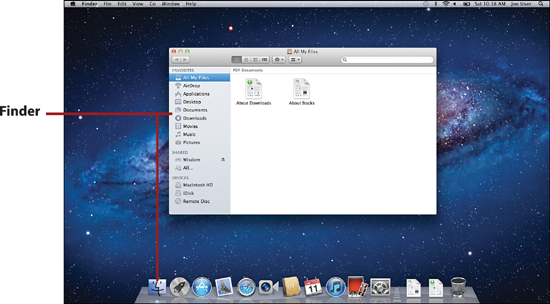Prologue
This book explains how to use and configure your MacBook and Lion to create your ideal working environment. Even though you’re working with the most intuitive hardware and software platform available, there are still tips and tricks to discover.
Let’s take a few minutes to review the hardware capabilities of your system and the prerequisites necessary to successfully use this book.
Getting to Know the MacBook Hardware
There are currently three different models of the MacBook available— MacBook Pro, MacBook Air, and MacBook. Each model includes a wide array of ports and plugs for connecting to other computers, handheld devices, and peripherals such as printers and external displays. I refer to these hardware options by name throughout the book, so it’s a good idea to familiarize yourself with them now.
• Ethernet—Ethernet provides high-speed wired network connections. Ethernet offers greater speeds and reliability than wireless service. Your MacBook supports a very fast version of Ethernet—Gigabit Ethernet—that makes it a first-class citizen on any home or corporate network.
• FireWire 800—FireWire 800 is a fast peripheral connection standard that is frequently used to connect external storage and video devices.
• Mini DisplayPort—The DisplayPort enables you to connect external monitors to your MacBook. Although few monitors support the DisplayPort standard, from Apple you can get adapters for connecting to both VGA and DVI interface standards.
• Thunderbolt—The highest speed interconnect available on a personal computer, Thunderbolt allows monitors, storage units, and other devices to be daisy-chained together.
• USB 2.0—Universal Serial Bus is a popular peripheral connection standard for everything from mice to scanners to hard drives.
• SD Card Slot—SD (Secure Digital) RAM cards are a popular flash RAM format used in many digital cameras. Using the built-in SD RAM slot, you can create a bootable system “disk” that can be used to start your computer in an emergency.
• Audio In—A connection for an external microphone.
• Audio Out—An output for headphones, speakers, or a home theater/amplifier system.
• 802.11n—The fastest standard currently available for consumer wireless network connections. Your MacBook’s wireless hardware can connect to any standards-based wireless access point for fast, long-range Internet access.
• Bluetooth—Bluetooth is used for connecting peripheral devices wirelessly to your Mac. Unlike 802.11n, Bluetooth has a more limited range, but it is easier to configure and doesn’t require a specialized base station to use.
• SuperDrive—An optical drive that can be used to write CDs and DVDs.
• Express Card—An expansion card for portable computers, 17″ MacBook Pros can take advantage of this flexible standard.
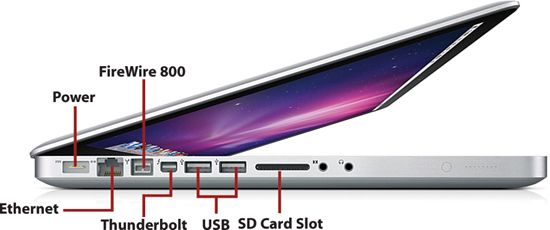
Photo courtesy of Apple.
So, what does your computer have? Apple’s MacBook lineup changes throughout the year, so your features will depend on the model and the date it was made. Be sure to consult your owner’s manual for a definitive description of what is included in your system.
The Built-In Battery
Looking for a way to remove your battery? Apple eliminated user-serviceable batteries from the MacBook line. This means that you now get a higher-capacity battery with a longer run-time, but, in the event of a failure, you can’t replace it yourself.
To replace the battery, you need to visit your local Apple store or registered service center. The battery can be replaced in the store, while you wait, for approximately $130.
Special Keyboard Keys
Take a look across the top of your keyboard. Notice that even though there are “F” (function) designations on the keys, there are also little icons. The keys marked with icons provide system-wide control over important Lion features.
• F1, F2—Dim and brighten the display, respectively
• F3—Starts Exposé and displays all application windows
• F4—Opens the Snow Leopard Dashboard
• F7, F8, F9—Rewind, Play, and Fast Forward during media playback
• F10, F11, F12—Mute, Decrease, and Increase Volume
The Eject key is located in the farthest-right corner of the keyboard and is used to eject any media in your MacBook’s SuperDrive.
What You Need to Know
If you’re holding this book in your hand, you can see that it contains a few hundred pages packed with information about using your MacBook with Lion. You might also notice books dedicated to the same topic and sitting on the same shelf at the bookstore that include a thousand pages or more! So what’s the difference?
My MacBook doesn’t cover the basics of using a computer; you already know how to drag windows around the screen and move files by dragging them from folder to folder. If you’re switching from Windows, however, you might encounter a few unique features of Mac OS X. Review these features in the next few sections.
The Menu Bar
The menu bar is universally accessible across all running applications and contains a combination of the Apple menu, which is used for accessing common system functions; the active application’s menus; and menu items, which are global utilities for controlling and monitoring system functions.
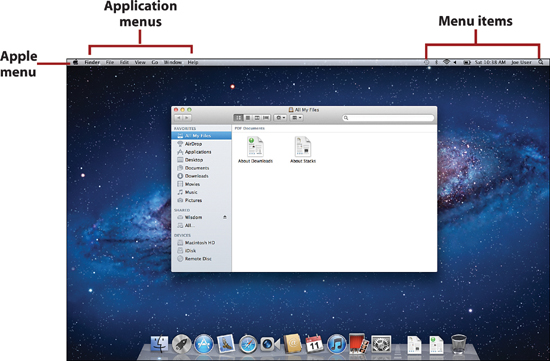
The Dock
The Lion Dock is the starting point for many of your actions when using the MacBook. Part application launcher, part file manager, and part window manager, the Dock gives you quick access to your most frequently used applications and documents without requiring that you navigate the Finder to find things on your hard drive.
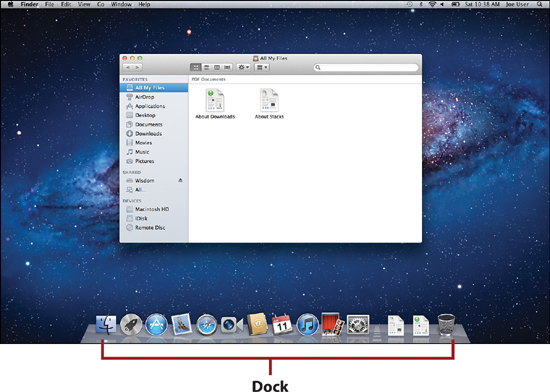
The Finder
In Windows, Explorer provides many of your file-management needs. In Mac OS X, you work with files within an ever-present application called Finder. The Finder is started as soon as you log into your computer and continues to run until you log out.
To switch to the Finder at any time, you click the blue smiling icon at the left end of the Dock.
System Preferences
Many features that this book explains how to configure require you to access the Lion System Preferences. The System Preferences application (accessible from the Dock or the Apple menu) is the central hub for system configuration. Everything from setting your password to choosing a screen saver can be found in the System Preferences application.

Window Controls
Lion provides up to four controls at the top of each window. On the left: close, minimize, and resize. The close control shuts the window; minimize slides the window off the screen and into the Dock; and resize changes the size of the window to best fit the content being displayed.
On the right side of the window is the fullscreen control. Clicking the fullscreen control switches an app to fullscreen if available. You might not expect it, but fullscreen applications on Lion can take on a completely different appearance from their windowed selves.

Contextual Menus
If you’re new to Mac OS X, you might find it hard to believe that, yes, the Mac has a “right-click” menu in its operating system and it’s been there for a long time! Contextual menus can be invoked by right-clicking using a multi-button mouse, Control-clicking with your trackpad, or click in the lower-right corner of the trackpad.
Contextual menus are rarely required in any application, but they can give you quick access to features that might otherwise take more clicks.
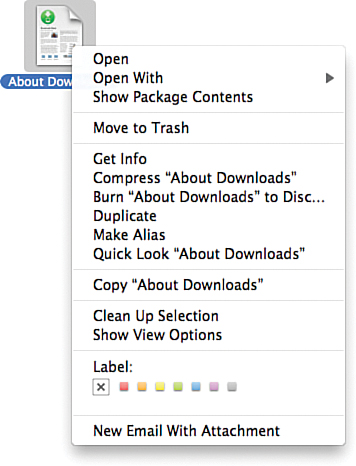
Gestures
Gestures are motions that you can make on your trackpad to control your computer. In Lion, gestures are used heavily to navigate between applications and access special features. Gestures can help you navigate web pages, resize images, and much more (such as launching Mission Control, seen here)—with just your fingertips. In fact, without gestures, you’ll likely miss out on all Lion has to offer.
Windows Compatibility
If you have a MacBook, you have a powerful Intel-based computer in your hands—a computer that is completely capable of natively running the Windows operating system. The goal of this book is to make you comfortable using your MacBook with Lion, but I’d be remiss in my authoring duties if I didn’t mention the options available for running Windows on your hardware.
Boot Camp
Boot Camp is included with Lion and gives you the ability to install and boot Windows directly on your MacBook. Quite simply, when you do this your Mac becomes a Windows computer. Switching between Lion and Windows requires a reboot, so this option is best if you need to work in Windows for extended periods of time.
Apple’s Boot Camp Assistant (found in the Utilities folder within the Applications folder) guides you through the process of partitioning your MacBook for Windows and burning a CD of drivers for windows, and configuring your system to boot into Windows or Mac OS X.
Boot Camp can be installed at any time as long as there is enough room (about 5GB) for a Windows installation.
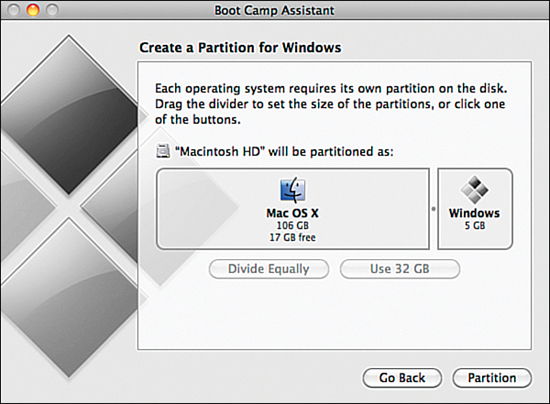
Virtualization
Another solution to the Windows-compatibility conundrum is the use of virtualization software. Through virtualization, you can run Windows at near-native speeds at the same time you run Lion. Some virtualization solutions even go so far as to mix Mac and Windows applications on the same screen, blurring the lines of operating systems.
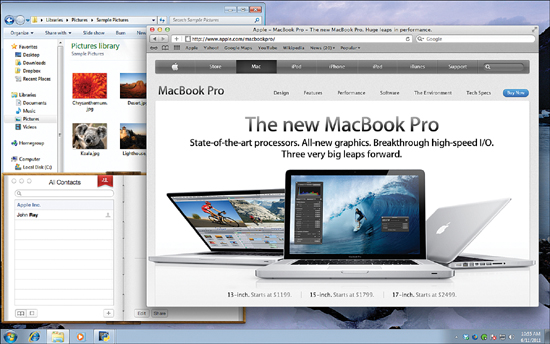
Unlike Boot Camp, virtualization runs operating systems simultaneously. Virtualization requires more resources and has lower performance than a Boot Camp solution, but it is more convenient for running an occasional application or game.
There are three options you should consider for virtualizing Windows on your MacBook:
1. VMWare Fusion (www.vmware.com)—A stable solution from a leader in virtualization software. VMWare Fusion is rock solid and fully compatible with a wide range of virtual “appliances” available for VMWare on Windows.
2. Parallels Desktop (www.parallels.com)—Parallels Desktop has the widest range of features available of any virtualization solution for Mac OS X, including near seamless integration with Snow Leopard.
3. VirtualBox (www.virtualbox.org)—Free virtualization software that offers many of the same features of VMWare and Parallels. VirtualBox is not as polished as the commercial solutions, but it’s well supported and has excellent performance.

